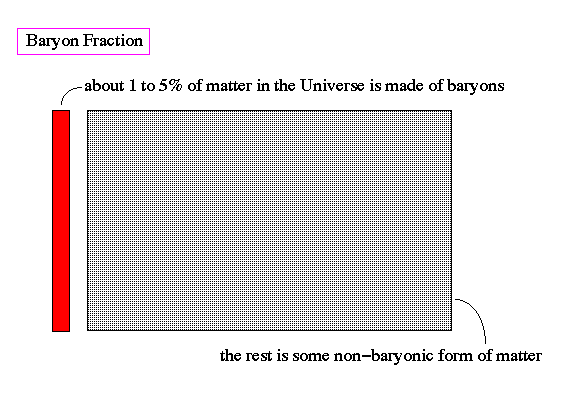
| Readings: |
Neutrinos |
Baryon Fraction:
The amount of hydrogen in the Universe today, either in stars and galaxies, or hot gas between galaxies, is called the baryon fraction. The current measurements indicate that the baryon fraction is about 2% (0.02) the value of closure for the Universe (the critical density). Remember the value from the abundance of light elements is between 2 and 3% (0.03) the closure value.

The most immediate result here is that the mass density of the Universe
appears to be much less than the closure value, i.e. we live in an open
Universe. However, the inflation model demands that we live in a Universe
with exactly the critical density, ![]() of 1. This can only be true if
about 90% of the mass of the Universe is not in baryons (either dark
matter or dark energy).
of 1. This can only be true if
about 90% of the mass of the Universe is not in baryons (either dark
matter or dark energy).
Neutrinos :
There are two types of leptons, the electron, muon and tau particle form one family with a second family defined by the family of neutrinos. The neutrino is a strange particle, not discovered directly until the 1970's, but by inference from the beta decay of other particles by Wolfgang Pauli in 1930. It has no charge and a very small mass. It interacts with other particles only through the weak force (i.e. it is immune to the strong and electromagnetic forces). The weak force is so weak, that a neutrino can pass through several Earth's of lead with only a 50/50 chance of interacting with an atom, i.e. they are effectively transparent to matter.
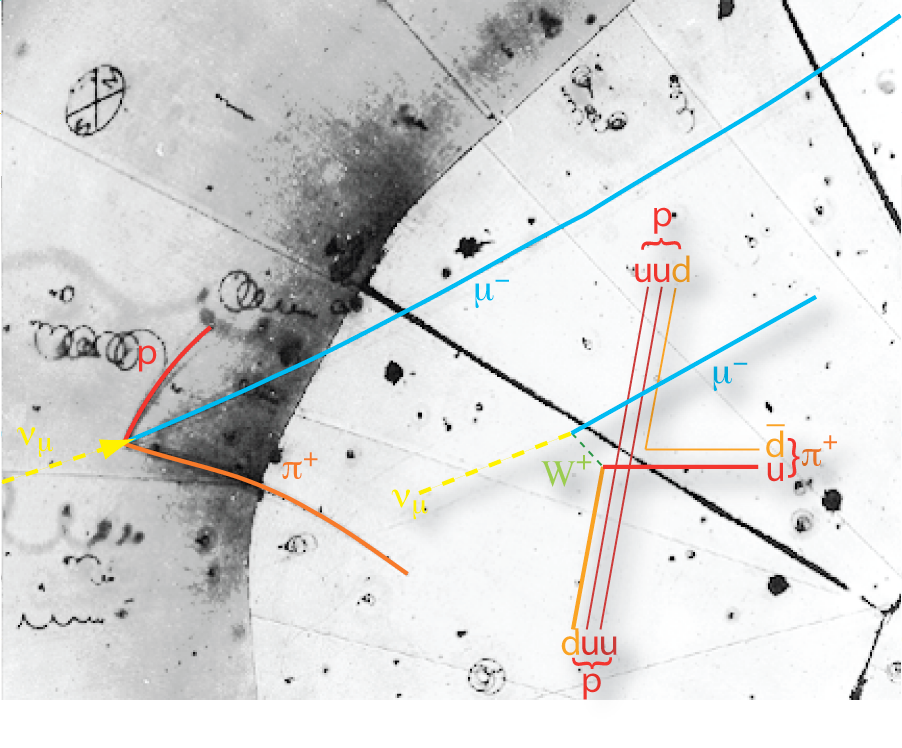
The world's first *direct* neutrino observation in a hydrogen bubble chamber was found Nov. 13, 1970, on this historical photograph (above) from the Zero Gradient Synchrotron's 12-foot bubble chamber. The invisible neutrino strikes a proton where three particle tracks originate (left). The neutrino turns into a mu-meson, the long center track. The short track is the proton. The third track is a pi-meson created by the collision.
The weakly interacting nature of neutrinos makes them very difficult to detect, and therefore measure, in experiments. Plus, the only sources of large amounts of neutrinos are high energy events such as supernova, relics from the early Universe and nuclear power plants. However, they are extremely important to our understanding of nuclear reactions since pratically every fusion reaction produces a neutrino. In fact, a majority of the energy produced by stars and supernova are carried away in the form of neutrinos (the Sun produces 100 trillion trillion trillion neutrinos every second).
In 1962 Leon M. Lederman, Melvin Schwartz and Jack Steinberger showed that more than one type of neutrino exists by first detecting interactions of the muon neutrino, which earned them the 1988 Nobel Prize. There are three known types (flavours) of neutrinos: electron neutrino νe, muon neutrino νμ and tau neutrino ντ, named after their partner leptons in the Standard Model.
Detecting neutrinos from the Sun was an obvious first experiment to measure neutrinos. The pioneering experiment was Ray Davis's 600 ton chlorine tank (actually dry cleaning fluid) in the Homestake mine, South Dakota. His experiment, begun in 1967, found evidence for only one third of the expected number of neutrino events. A light water Cherenkov experiment at Kamioka, Japan, upgraded to detect solar netrinos in 1986, finds one half of the expected events for the part of the solar neutrino spectrum for which they are sensitive. Two recent gallium detectors (SAGE and GALLEX), which have lower energy thresholds, find about 60-70% of the expected rate.
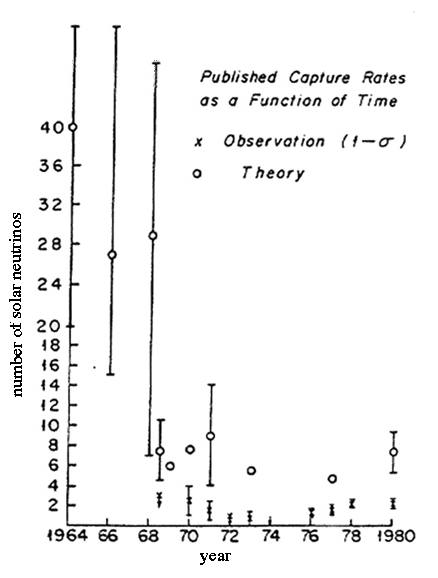
The clear trend is that the measured flux is found to be dramatically less than is possible for our present understanding of the reaction processes in stars. There are two possible answers to this problem: 1) The structure and constitution of stars, and hence the reaction mechanisms are not correctly understood (this would be a real blow for models that have otherwise been very successful), or 2) something happens to the neutrinos in transit to earth; in particular, they might change into another type of neutrino, called oscillation (this idea is not as crazy as it sounds, as a similar phenomenon is well known to occur with the meson particles).
Neutrino oscillation is a quantum mechanical phenomenon whereby a neutrino created with a specific lepton flavor (electron, muon or tau) can later be measured to have a different flavor. The probability of measuring a particular flavor for a neutrino varies periodically as it propagates. Neutrino oscillation is of theoretical and experimental interest as observation of the phenomenon implies that the neutrino has a non-zero mass (unlike the photon which has zero mass), which is not part of the original Standard Model of particle physics.
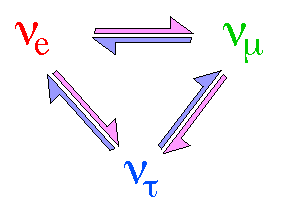
By the late 1990s, the oscillation hypothesis is shown to be correct. In addition, analysis of the neutrino events from the supernova 1987A indicates that the neutrinos traveled at slightly less than the speed of light. This is an important result since the neutrino is so light that it was unclear if its mass was very small or exactly zero. Zero mass particles (like the photon) must travel exactly the speed of light (no faster, no slower). But objects with mass must travel at less than the speed of light as stated by special relativity.
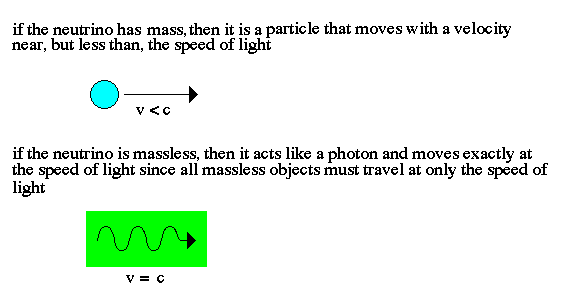
Since neutrino's interact very weakly, they are the first particles to decouple from other particles, at about 1 sec after the Big Bang. The early Universe is so dense that even neutrinos are trapped in their interactions. But as the Universe expands, its density drops to the point where the neutrinos are free to travel. This happens when the rate at which neutrinos are absorbed and emitted (the weak interaction rate) becomes slower than the expansion rate of the Universe. At this point the Universe expands faster than the neutrinos are absorbed and they take off into space (the expanding space).
Now that neutrinos have been found to have mass, they also are important to our cosmology as a component of the cosmic density parameter. Even though each individual neutrino is much less massive than an electron, trillions of them are produced for every electron in the early Universe. Thus, neutrinos must make up some fraction of the non-baryonic matter in the Universe (although not alot of it, see lecture on the large scale structure of the Universe).
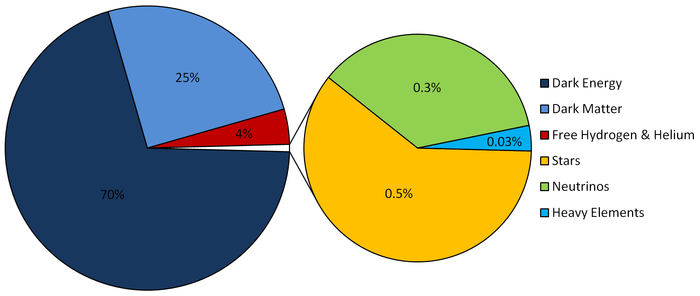

|
|

|